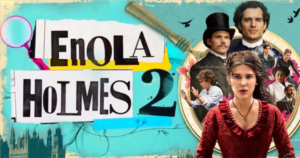The Story Circle involves characters who venture out to seek something they need and return to their familiar situations as changed persons. This approach was created by Dan Harmon and derived from “The Hero’s Journey,” which was adapted from the work of American professor Joseph Campbell. It uses a narrative arc that’s commonly found in mythological stories from around the world and emphasizes how almost every form of storytelling has a cyclical nature.

Scene from “Community”
Structure of the Story Circle
While The Hero’s Journey consists of 11 steps, the Story Circle has only eight steps, which include:
- A character is in a comfortable situation
- However, they seek something
- They venture into an unfamiliar place
- They get used to the new situation
- They get what they’re looking for
- They pay a high price for it
- They go back to their familiar situation
- Nevertheless, they have changed
The Importance of the Story Circle
Some experts think that Dan Harmon’s Story Circle is more useful than The Hero’s Journey because it encompasses every type of story, from romantic stories to comedies. Some of the components of The Hero’s Journey allude to a particular kind of story, such as tales of squires becoming knights and finding potions in hidden caves. Harmon refined the steps in this story structure to focus more on the character. As such, the Story Circle applies to a broader range of stories.
How the Story Circle Is Applied to “Rick and Morty”
To see the Story Circle in action in “Rick and Morty,” take a look at Morty’s journey in the “Mortynight Run” episode, which comprises the following steps:
- A character is in a comfortable situation: At the beginning of the story, it seems like Rick and Morty will be going on just another adventure. Morty is in his comfort zone until he realizes that Rick is involved in arms dealing.
- However, they seek something: Morty finds himself in an ethical dilemma. A feeling of guilt compels him to go beyond a threshold and look for a way to revert the ethical damage he thinks Rick is doing.
- They venture into an unfamiliar place: Although he seldom goes against his grandfather’s instructions, Morty drives Rick’s car to chase after the assassin but accidentally kills him.
- They get used to the new situation: Morty finds out that the assassin’s target was an alien gas entity called Fart. Defying Rick’s instructions again, he helps Fart escape from space jail.
- They get what they’re looking for: Morty achieved his goal by saving a life. Now, he feels good that he has done something right.
- They pay a high price for it: However, in the second half of the episode, Morty realizes that saving Fart is going to cause many people to lose their lives. The alien starts to kill many cops, while Rick and Morty try to make their escape.
- They go back to their familiar situation: Rick and Morty return to a familiar place that resembles “normal life.” Now, Morty knows that Fart is a truly evil creature who plans to return with his people to kill all carbon-based lifeforms.
- Nevertheless, they have changed: Morty decides to change into a killer. He eliminates Fart and saves the universe, but he has become someone totally different from who he used to be.

Scene from “Rick and Morty”
How the “The Dark Knight” Fits Into the Story Circle
As mentioned earlier, the Story Circle applies to almost every story, even a complex one such as “The Dark Knight.”

Scene from “The Dark Knight”
You can watch the following video to find out how the rich and dense plot of this iconic superhero movie adheres to Harmon’s simple eight-step story structure:
Why Is the Story Circle a Circle?
You may wonder why the Story Circle isn’t laid out in a flat line. Harmon talked about the rhythms of biology and psychology and the way things move cyclically through phases of the conscious and unconscious, order and chaos, and life and death. One fascinating thing he pointed out is that these cycles have enabled human beings to evolve.
Stories are a fundamental and universal part of human culture as a result of their long history as an educational tool. The idea of seeking, changing, and returning isn’t a concept created for lazy writers, but it’s an integral part of the human psyche. This is the reason why stories from a particular culture can resonate with people around the world. The cyclical structure of the Story Circle can be seen in almost every story, regardless of their origins.
Is the Story Circle Really Applicable to All Stories?
According to Dan Harmon, the answer is “yes.” To put the claim to the test, let’s take a look at an example that’s very different from a profane animated show like “Rick and Morty”: Charles Dickens’s “Great Expectations.”
- A character is in a comfortable situation: A young orphan called Pip lives a simple life on the moors.
- However, they seek something: Later on, he becomes obsessed with a wealthy girl called Estella, who is of the same age as him.
- They venture into an unfamiliar place: A benefactor takes Pip out of obscurity and introduces him to the London society.
- They get used to the new situation: He learns how to live the high life, spending his money extravagantly.
- They get what they’re looking for: Now that he has finally become a gentleman, he believes he’s worthy of Estella.
- They pay a high price for it: Pip realizes that the person who gave him money is a convict. He falls into debt, regrets cutting off his relationship with his Uncle Joe, and finds that his endeavor to pursue Estella is futile.
- They go back to their familiar situation: He returns to his uncle, who helps him become healthy again. Then, he travels to Egypt and stays there for years.
- Nevertheless, they have changed: The story goes back to where it started. A now-humbled Pip reunites with his romantic interest Estella, who opens her heart to him.

Scene from “Great Expectations” (TV series)
“Great Expectations” was written and published on a weekly basis, but it seems that Dickens was consciously or unconsciously aware of this cyclical structure. He made his protagonist go on a journey to seek something, pay the price, and then return home a changed person.
If you want to learn more about the Story Circle or other writing or filmmaking techniques, consider signing up for the nine-month Cinema Production Diploma program at Nashville Film Institute. Contact us today to find out more about our courses.














